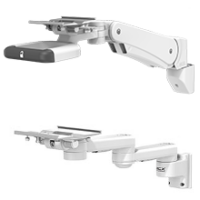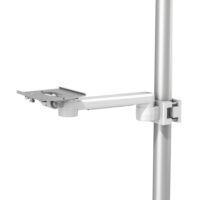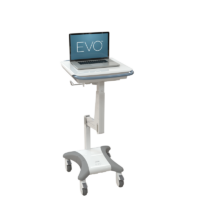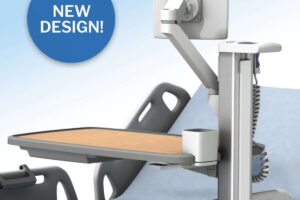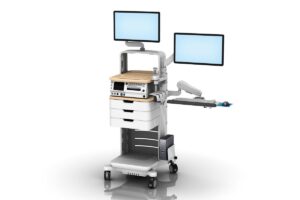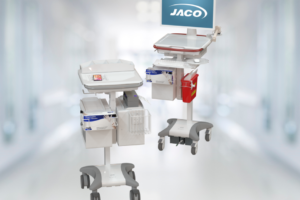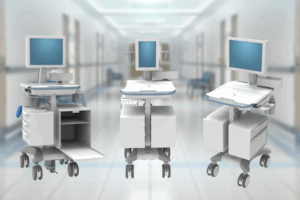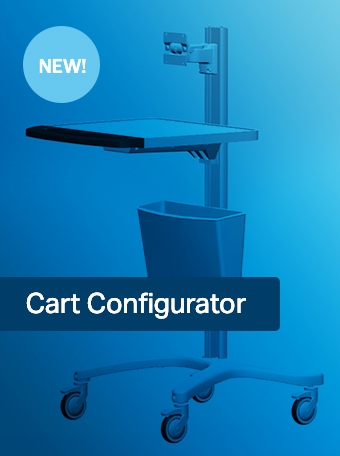
-
Solutions
Care Area Solutions
Standardize GCX mounting solutions throughout your healthcare facility.
IT and EMR Solutions
Mounting solutions for Information Technology and Electronic Medical Records equipment.
Mounting solutions based on your mounting location.
Medical Device Solutions
Mounting solutions designed specifically for your medical and patient monitoring devices.
-
Products
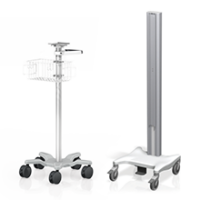
Carts and Roll Stands
Variable Height
Fixed Height
Accessories
- 10 x 25 mm Rails
- Barcode Scanner Mounts
- Baskets and Bins
- Cable Management
- Camera Mounts
- Channels
- CPU Mounts
- Data Capture Device Mounts
- Down Posts
- Drawers
- Gas Cylinder Mounts
- Gel Bottle Mount
- Handles
- Keyboard Trays and Plates
- Medical-Grade Power Strips
- Mountable Tablet Enclosures
- PolyQuip® Post and I.V. Bag Hanger Mounts
- Power Supply Mounts
- Probe Cup Mount
- Speaker Mount
- Tablet Integration
- Trays
- UPS Mounts
- USB Charging Modules
- VESA Adapter Plates
-
OEM Services
Mounting solutions for medical device OEM partners range from off-the-shelf to complete custom products.
Approach
Modalities
- Ventilation
- Ultrasound
- Patient Monitoring
- Telemedicine
- Surgical Navigation
- ECG Solutions
- Other Modalities
Our Expertise
-
Support
-
About GCX
Tablets at the Bedside: Protecting the Devices
By GCX Corporation on June 6, 2016 in Medical Devices, Medical Mounting Solutions, Mobile Devices, Tablets
Generally speaking, hospitalized patients can have difficulty using a tablet device because (a) they may be unable to a grip the device securely; (b) they can’t position it for comfortable viewing from a bed or chair; or (c) they may drop it on the floor, causing damage.
Freestanding devices also pose considerable security and privacy risks, given how easily someone can walk off with a tablet that may contain protected health information (PHI).
This is why device protection is so important. Commercial tablet protective covers might mitigate the damage from drops and make the devices easier to handle. But they fall short when it comes to security, mounting ability, port access, cable management and infection control, including withstanding harsh hospital cleaning solutions in between use. They also tend to be brand-specific and incompatible with other devices.
These are just some of the reasons hospitals, particularly those that deploy their own tablets for patient use are looking at a more secure solution: a permanent mount built into a common piece of equipment such as the ubiquitous over-bed table.
Minimizing damages and loss through a solid mounting solution
Whether hospital-issued or personally purchased, a tablet represents a significant technology investment worth protecting from harm or theft. Generally speaking, commercial/consumer tablet devices do not offer a mechanical interface typically found on most flat panel displays, such as a VESA interface, to safely mount the tablet to a secured surface. Some solutions are available commercially, but they don’t work with every device and may not meet medical standards.
One such standard involves product hygiene. With anything a patient uses, cleaning and infection control become a concern. Hospital rooms must continually be disinfected to healthcare cleaning protocols to reduce infection risks from airborne and contact germs. Many consumer-grade tablet covers and enclosures cannot withstand repeated cleanings with abrasive materials. But a mounting solution built to rigorous sanitary standards will stand up to the harsh cleansers without impacting tablet performance or raising the risk of infection. An adjustable mount also reduces the chances of liquid (including cleansers) seeping into a tablet’s openings.
All tablets require either constant power or periodic power to recharge the device’s battery. At least one cable, and perhaps more, needs to have access in/out of the enclosure and also be regularly cleaned. A healthcare facility must determine which ports and controls on the device will be accessible to patients.
Readying for the ‘next big thing’ … and the ‘next big thing’ … and the next . . .
Another common complication: providing enclosures and protective covers that will work with future versions of the tablet. The consumer market releases new versions of popular consumer electronics as often as every few months. Unless an institution purchases many of the same devices as spares for repair/replacement, this year’s enclosures may quickly become unusable.
At GCX, we intend to continue finding the best ways to integrate and design robust tablet enclosures and mounting hardware that both securely positions the device for patient use and allows for necessary infection control practice. We will continue this development as devices evolve, so that our customers will be able to accommodate and, as needed, refresh the tablets they use to engage patients.
Recent Blog Posts
- Patient Engagement July 15, 2025
- Understanding Patient Experience June 4, 2025
- Preventive Maintenance for Medical Devices April 15, 2025
- Hospital Asset Tracking Systems: Integration Maximizes Value March 27, 2025
- Bring IT December 13, 2023
Blog Categories
- Anesthesia
- Asset Tracking & Preventative Maintenance
- Case Studies
- Custom Solutions
- EMR Hardware
- Endoscopy
- Ergonomics
- Fetal Monitoring
- Headwalls
- HIMSS
- Medical Computer Carts
- Medical Devices
- Medical Mounting Solutions
- Mobile Devices
- On-Site Services
- Patient Engagement Table
- Patient Experience
- Tablets
- VHM-PL





















